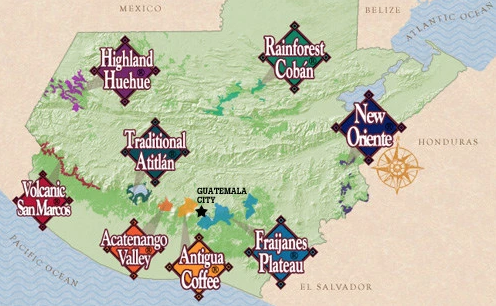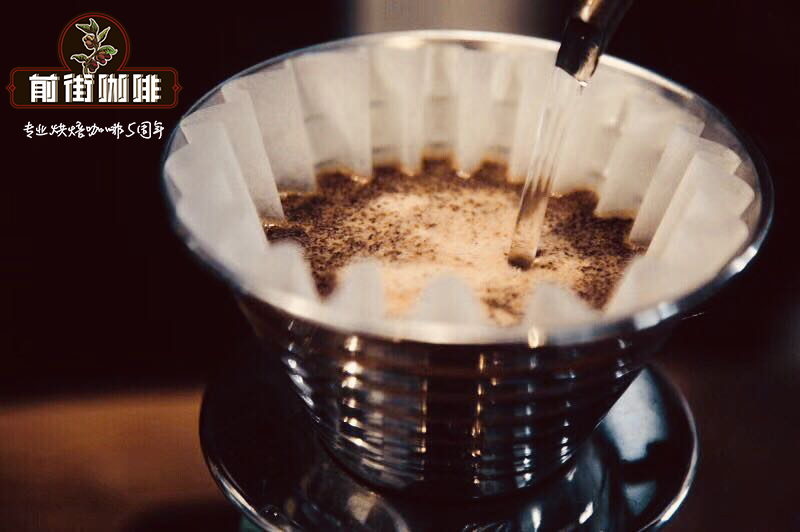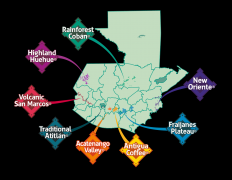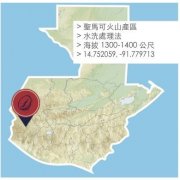Introduction to the New Oriental Coffee Bean producing area in Guatemala the flavor characteristics of Guatemalan coffee beans
New Oriental producing area
New Oriental production area is located in the southeast of Guatemala, along the way you will drive through the desert climate and see the desert hills like Texas in the United States. It is a 5-hour drive from the capital to the New Oriental region at an altitude of 1300-1700m. It is located on the border of El Salvador and Honduras, located in the dormant volcanic zone. The soil formed by metamorphic rocks is mixed with minerals after volcanism to balance the local soil composition, so the soil composition here is very different from that in other areas with frequent volcanic activity. And the coffee is very meticulous and rich in flavor. New Oriental coffee contains aroma, obvious acidity and good texture.
The New Oriental region, which has been growing coffee since 1950, is now full of vitality and development in the mountains, but it was once one of the poorest and most remote areas in Guatemala. Most of the coffee in the New Oriental region comes from small family-owned estates, which also grow other basic crops as daily food. This area is rapidly becoming more and more famous among coffee connoisseurs, and their demand for coffee is increasing year by year. As a result, every farm on the mountain has shifted to growing coffee, replacing other crops as the main source of products and income. The climate in the producing area is cloudy and rainy, which is located in the area with frequent volcanic activity in the past. The soil here is made up of metamorphic rocks that evenly mix many minerals, which is different from other volcanic soil producing areas, but also contains many nutrients to enable coffee trees to grow healthily.
Because of such a rich microclimate, Lake Attila can be said to be one of the most interesting producing areas every time we test it. She can be like classic Antigua honey, chocolate, oranges, and sometimes with the high acidity of Viagra, or even the tonality of peaches and plums.

■ altitude: 1300-1700m
■ annual rainfall: 1800mm to 2000mm
■ average temperature: 18: 25 ℃
■ relative humidity: 70-80%
■ harvest season: December to March
■ soil: metamorphic rock and clay
■ main drying method process: sunshine and dryer
■ shade species: Inga
■ main topography: volcano
■ coffee is well balanced and full-bodied, with a hint of chocolate.

Important Notice :
前街咖啡 FrontStreet Coffee has moved to new addredd:
FrontStreet Coffee Address: 315,Donghua East Road,GuangZhou
Tel:020 38364473
- Prev

A brief history of Guatemalan coffee grading system and flavor characteristics of Guatemalan coffee
A brief history of Guatemalan coffee "Republic of Guatemala", commonly known as Guatemala, also means "place with many trees". It is located in Central America, with the Pacific Ocean to the west, the Atlantic Ocean to the east, Mexico to the north, and Honduras and El Salvador to the southeast. Located in Central America, Guatemala is the sixth largest coffee producer in the world, and coffee has always been driving Guatemala horses.
- Next

Introduction of San Marco Volcano Coffee producing area in Guatemala the flavor characteristics of coffee beans in San Marco producing area
The San Marco volcano producing area is the highest rainfall and warmest of the eight producing areas in Guatemala. The ash provided by Santiaguito, a nearby active volcano, makes its soil more fertile. The seasonal rainfall comes earlier than in other areas, so the coffee in this area
Related
- Beginners will see the "Coffee pull flower" guide!
- What is the difference between ice blog purified milk and ordinary milk coffee?
- Why is the Philippines the largest producer of crops in Liberia?
- For coffee extraction, should the fine powder be retained?
- How does extracted espresso fill pressed powder? How much strength does it take to press the powder?
- How to make jasmine cold extract coffee? Is the jasmine + latte good?
- Will this little toy really make the coffee taste better? How does Lily Drip affect coffee extraction?
- Will the action of slapping the filter cup also affect coffee extraction?
- What's the difference between powder-to-water ratio and powder-to-liquid ratio?
- What is the Ethiopian local species? What does it have to do with Heirloom native species?

